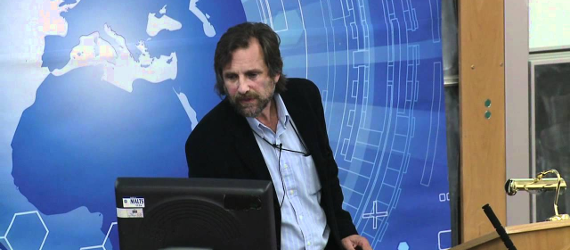 As I think I've mentioned before, I now assume that most gongs are handed out to people, not for public service, but for "going the extra mile" in the furtherance of a cause dear to ministers' hearts. I was reminded of this when I read James Verdon's devastating take down of an article by our old friend Stuart Haszeldine OBE, professor of carbon capture and storage at the University of Edinburgh.
As I think I've mentioned before, I now assume that most gongs are handed out to people, not for public service, but for "going the extra mile" in the furtherance of a cause dear to ministers' hearts. I was reminded of this when I read James Verdon's devastating take down of an article by our old friend Stuart Haszeldine OBE, professor of carbon capture and storage at the University of Edinburgh.
I first came across the good professor when I appeared at a Spectator debate on windfarms, and he spent a section of his talk bad-mouthing The Hockey Stick Illusion, before admitting that he hadn't actually read it. I'm therefore always on the lookout for his latest utterances. Earlier this week, he and colleagues from his group at Edinburgh wrote an article for the Energy and Carbon blog about waste water disposal in the oil and gas industry, with a particular focus shale gas fields. Unconventional oil and gas is not obviously where their expertise lies, and so one might have expected a few errors to have crept in to their text, but as James Verdon points out in his response, the level of incorrectness is...a bit of a worry.
For example, they misrepresent the situation in Oklahoma, where there has been a rash of earth tremors. Haszeldine and friends say that this was due to injection of produced water from shale wells. As readers here know, it is actually water from conventional oil wells that is involved.
They also say that waste water injection has led to environmental contamination caused by leaks. This is backed up with a citation of a Desmog article (snigger) that only makes claims about "fears" of such contamination. And as James Verdon points out, this is again mostly water from conventional fields and, moreover, the regulators involved have given the wells a clean bill of health.
Haszeldine et al go on to grossly misrepresent the position of the Environment Agency, suggesting that it is going to allow wastewater injection on a massive scale, when in fact it has only left it open as an approach that might be used in exceptional circumstances.
But the real sting is in the tail of the piece, where Verdon points out that all of the problems that Haszeldine et al claim will afflict waste-water disposal apply to carbon capture and storage, only more so:
[In CCS] the injected fluid is in chemical dis-equilibrium with the in situ geological formation – indeed CO2 will dissolve into formation waters to create a mildly corrosive acid, which is not a problem for flowback or produced water re-injection; the CO2 will likely be stored in saline aquifers that have not been depleted, leading to the same issues with pressure increases and potential seismicity described by ODGH...only the volumes of CO2 to be stored far exceed the volumes of flowback typically re-injected, which will exacerbate the risk of larger seismic events. I would appreciate it if the authors could outline in more detail how it is that they can be fully supportive of CCS development, and yet believe these same issues pose a major issue with respect to the re-injection of other waste fluids.